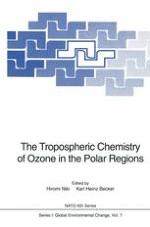1993 | OriginalPaper | Chapter
The Relationship between Anthropogenic Nitrogen Oxides and Ozone Trends in the Arctic Troposphere
Author : Dan Jaffe
Published in: The Tropospheric Chemistry of Ozone in the Polar Regions
Publisher: Springer Berlin Heidelberg
Included in: Professional Book Archive
Activate our intelligent search to find suitable subject content or patents.
Select sections of text to find matching patents with Artificial Intelligence. powered by
Select sections of text to find additional relevant content using AI-assisted search. powered by
Low solar insolation and low precipitation rates dramatically slow down the oxidation and removal of many anthropogenic pollutants in the Arctic, including hydrocarbons and nitrogen oxides. These processes give rise to a seasonal pollutant accumulation in the Arctic often referred to as “Arctic Haze”, with a maximum in the winter-spring period. There is some evidence that the wintertime accumulation of these constituents occurs not only in the Arctic but also in other remote Northern Hemispheric locations as well. Penkett and Brice [1986] suggest that a hemispheric buildup of nitrogen oxides and hydrocarbons contributes to the observed springtime maximum in ozone which is usually attributed to stratospheric exchange. Based on modeling studies, Isaksen et al. [1985] have found that the arctic reservoir of nitrogen oxides can play a significant role in ozone production in the spring.
